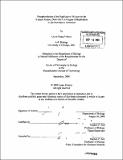Phosphorylation of the replicative helicase by the S-phase kinase, Dbf4-Cdc7, at origins of replication in Saccharomyces cerevisiae
Author(s)
Francis, Laura Ileana
DownloadFull printable version (20.89Mb)
Other Contributors
Massachusetts Institute of Technology. Dept. of Biology.
Advisor
Stephen P. Bell.
Terms of use
Metadata
Show full item recordAbstract
In eukaryotic cells, events such as DNA replication and mitosis must be carefully coordinated in the cell cycle to ensure that the entire genome is duplicated before cells undergo cell division. In particular, initiation of DNA replication occurs in two temporally distinct steps, selection of sites of initiation (called origins) and activation of these selected sites. Selection of origins occurs in late M- and early Gl-phase and is mediated by the origin DNA-binding protein called the Origin Recognition Complex (ORC). ORC recruits several proteins to the DNA, including the Mcm2-7 replicative helicase, to form the pre-Replicative Complex (pre-RC). Origins are activated by recruitment of other initiation factors to the pre-RC to form the pre-Initiation Complex (pre-IC) and this event requires two kinases, Cyclin Dependent Kinase (CDK) and Dbf4Dependent Kinase, Dbf4-Cdc7 (DDK). These events lead to activation of the Mcm2-7 helicase and recruitment of DNA synthesis machinery The S-phase kinase, DDK, phosphorylates the Mcm2-7 helicase, and is thought to be required either for helicase activation or for recruitment of pre-IC factors (or both). To gain a better mechanistic understanding of the role of DDK in initiation, we developed a biochemical assay to examine the DDK phosphorylation of pre-RC-linked Mcm2-7 complex. We found that DDK specifically targets the MCM complex and is recruited to the origin by the MCM complex. DDK preferentially phosphorylates the MCM complexes most tightly linked to the DNA. Moreover, prior phosphorylation of the MCM complex is required for DDK binding to, and phosphorylation of, the MCM complex suggesting that another, as yet unknown kinase, is also required to initiate DNA replication. (cont.) To further understand the multiple phosphorylation events that may be required for activation of the helicase, phosphorylation sites were mapped on pre-RC-linked MCM complexes. Each phosphorylated MCM subunit contained both DDK-dependent and independent phosphorylation sites except Mcm5. In sum, the work described herein provides a model for how DDK specifically targets those MCM complexes taking part in DNA replication. Moreover, this work provides a stepping off point for many future mechanistic studies to understand the role of DDK, and other kinases, in initiation of DNA replication.
Description
Thesis (Ph. D.)--Massachusetts Institute of Technology, Dept. of Biology, 2008. Includes bibliographical references.
Date issued
2008Department
Massachusetts Institute of Technology. Department of BiologyPublisher
Massachusetts Institute of Technology
Keywords
Biology.